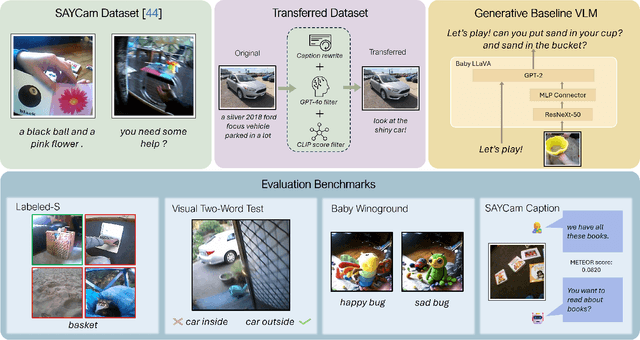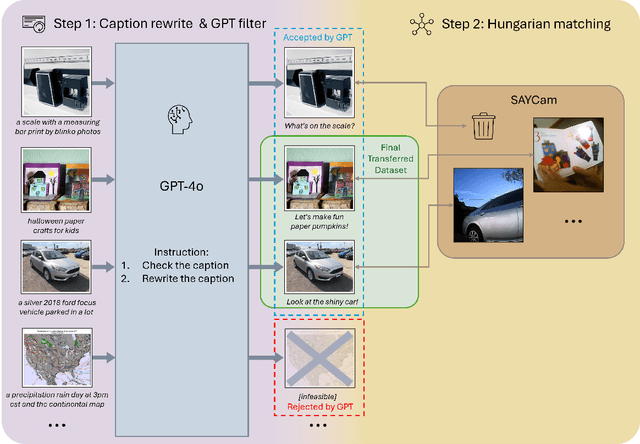Venkatesh Saligrama
BabyVLM: Data-Efficient Pretraining of VLMs Inspired by Infant Learning
Apr 13, 2025



Abstract:Human infants rapidly develop visual reasoning skills from minimal input, suggesting that developmentally inspired pretraining could significantly enhance the efficiency of vision-language models (VLMs). Although recent efforts have leveraged infant-inspired datasets like SAYCam, existing evaluation benchmarks remain misaligned--they are either too simplistic, narrowly scoped, or tailored for large-scale pretrained models. Additionally, training exclusively on infant data overlooks the broader, diverse input from which infants naturally learn. To address these limitations, we propose BabyVLM, a novel framework comprising comprehensive in-domain evaluation benchmarks and a synthetic training dataset created via child-directed transformations of existing datasets. We demonstrate that VLMs trained with our synthetic dataset achieve superior performance on BabyVLM tasks compared to models trained solely on SAYCam or general-purpose data of the SAYCam size. BabyVLM thus provides a robust, developmentally aligned evaluation tool and illustrates how compact models trained on carefully curated data can generalize effectively, opening pathways toward data-efficient vision-language learning paradigms.
Enhancing Compositional Reasoning in Vision-Language Models with Synthetic Preference Data
Apr 07, 2025



Abstract:Compositionality, or correctly recognizing scenes as compositions of atomic visual concepts, remains difficult for multimodal large language models (MLLMs). Even state of the art MLLMs such as GPT-4o can make mistakes in distinguishing compositions like "dog chasing cat" vs "cat chasing dog". While on Winoground, a benchmark for measuring such reasoning, MLLMs have made significant progress, they are still far from a human's performance. We show that compositional reasoning in these models can be improved by elucidating such concepts via data, where a model is trained to prefer the correct caption for an image over a close but incorrect one. We introduce SCRAMBLe: Synthetic Compositional Reasoning Augmentation of MLLMs with Binary preference Learning, an approach for preference tuning open-weight MLLMs on synthetic preference data generated in a fully automated manner from existing image-caption data. SCRAMBLe holistically improves these MLLMs' compositional reasoning capabilities which we can see through significant improvements across multiple vision language compositionality benchmarks, as well as smaller but significant improvements on general question answering tasks. As a sneak peek, SCRAMBLe tuned Molmo-7B model improves on Winoground from 49.5% to 54.8% (best reported to date), while improving by ~1% on more general visual question answering tasks. Code for SCRAMBLe along with tuned models and our synthetic training dataset is available at https://github.com/samarth4149/SCRAMBLe.
Constrained Linear Thompson Sampling
Mar 03, 2025Abstract:We study the safe linear bandit problem, where an agent sequentially selects actions from a convex domain to maximize an unknown objective while ensuring unknown linear constraints are satisfied on a per-round basis. Existing approaches primarily rely on optimism-based methods with frequentist confidence bounds, often leading to computationally expensive action selection routines. We propose COnstrained Linear Thompson Sampling (COLTS), a sampling-based framework that efficiently balances regret minimization and constraint satisfaction by selecting actions on the basis of noisy perturbations of the estimates of the unknown objective vector and constraint matrix. We introduce three variants of COLTS, distinguished by the learner's available side information: - S-COLTS assumes access to a known safe action and ensures strict constraint enforcement by combining the COLTS approach with a rescaling towards the safe action. For $d$-dimensional actions, this yields $\tilde{O}(\sqrt{d^3 T})$ regret and zero constraint violations (or risk). - E-COLTS enforces constraints softly under Slater's condition, and attains regret and risk of $\tilde{O}(\sqrt{d^3 T})$ by combining COLTS with uniform exploration. - R-COLTS requires no side information, and ensures instance-independent regret and risk of $\tilde{O}(\sqrt{d^3 T})$ by leveraging repeated resampling. A key technical innovation is a coupled noise design, which maintains optimism while preserving computational efficiency, which is combined with a scaling based analysis technique to address the variation of the per-round feasible region induced by sampled constraint matrices. Our methods match the regret bounds of prior approaches, while significantly reducing computational costs compared to them, thus yielding a scalable and practical approach for constrained bandit linear optimization.
SPARC: Score Prompting and Adaptive Fusion for Zero-Shot Multi-Label Recognition in Vision-Language Models
Feb 24, 2025Abstract:Zero-shot multi-label recognition (MLR) with Vision-Language Models (VLMs) faces significant challenges without training data, model tuning, or architectural modifications. Existing approaches require prompt tuning or architectural adaptations, limiting zero-shot applicability. Our work proposes a novel solution treating VLMs as black boxes, leveraging scores without training data or ground truth. Using large language model insights on object co-occurrence, we introduce compound prompts grounded in realistic object combinations. Analysis of these prompt scores reveals VLM biases and ``AND''/``OR'' signal ambiguities, notably that maximum compound scores are surprisingly suboptimal compared to second-highest scores. We address these through a debiasing and score-fusion algorithm that corrects image bias and clarifies VLM response behaviors. Our method enhances other zero-shot approaches, consistently improving their results. Experiments show superior mean Average Precision (mAP) compared to methods requiring training data, achieved through refined object ranking for robust zero-shot MLR.
Deep Companion Learning: Enhancing Generalization Through Historical Consistency
Jul 26, 2024



Abstract:We propose Deep Companion Learning (DCL), a novel training method for Deep Neural Networks (DNNs) that enhances generalization by penalizing inconsistent model predictions compared to its historical performance. To achieve this, we train a deep-companion model (DCM), by using previous versions of the model to provide forecasts on new inputs. This companion model deciphers a meaningful latent semantic structure within the data, thereby providing targeted supervision that encourages the primary model to address the scenarios it finds most challenging. We validate our approach through both theoretical analysis and extensive experimentation, including ablation studies, on a variety of benchmark datasets (CIFAR-100, Tiny-ImageNet, ImageNet-1K) using diverse architectural models (ShuffleNetV2, ResNet, Vision Transformer, etc.), demonstrating state-of-the-art performance.
Testing the Feasibility of Linear Programs with Bandit Feedback
Jun 21, 2024

Abstract:While the recent literature has seen a surge in the study of constrained bandit problems, all existing methods for these begin by assuming the feasibility of the underlying problem. We initiate the study of testing such feasibility assumptions, and in particular address the problem in the linear bandit setting, thus characterising the costs of feasibility testing for an unknown linear program using bandit feedback. Concretely, we test if $\exists x: Ax \ge 0$ for an unknown $A \in \mathbb{R}^{m \times d}$, by playing a sequence of actions $x_t\in \mathbb{R}^d$, and observing $Ax_t + \mathrm{noise}$ in response. By identifying the hypothesis as determining the sign of the value of a minimax game, we construct a novel test based on low-regret algorithms and a nonasymptotic law of iterated logarithms. We prove that this test is reliable, and adapts to the `signal level,' $\Gamma,$ of any instance, with mean sample costs scaling as $\widetilde{O}(d^2/\Gamma^2)$. We complement this by a minimax lower bound of $\Omega(d/\Gamma^2)$ for sample costs of reliable tests, dominating prior asymptotic lower bounds by capturing the dependence on $d$, and thus elucidating a basic insight missing in the extant literature on such problems.
SynCDR : Training Cross Domain Retrieval Models with Synthetic Data
Dec 31, 2023Abstract:In cross-domain retrieval, a model is required to identify images from the same semantic category across two visual domains. For instance, given a sketch of an object, a model needs to retrieve a real image of it from an online store's catalog. A standard approach for such a problem is learning a feature space of images where Euclidean distances reflect similarity. Even without human annotations, which may be expensive to acquire, prior methods function reasonably well using unlabeled images for training. Our problem constraint takes this further to scenarios where the two domains do not necessarily share any common categories in training data. This can occur when the two domains in question come from different versions of some biometric sensor recording identities of different people. We posit a simple solution, which is to generate synthetic data to fill in these missing category examples across domains. This, we do via category preserving translation of images from one visual domain to another. We compare approaches specifically trained for this translation for a pair of domains, as well as those that can use large-scale pre-trained text-to-image diffusion models via prompts, and find that the latter can generate better replacement synthetic data, leading to more accurate cross-domain retrieval models. Code for our work is available at https://github.com/samarth4149/SynCDR .
Learning Human Action Recognition Representations Without Real Humans
Nov 10, 2023



Abstract:Pre-training on massive video datasets has become essential to achieve high action recognition performance on smaller downstream datasets. However, most large-scale video datasets contain images of people and hence are accompanied with issues related to privacy, ethics, and data protection, often preventing them from being publicly shared for reproducible research. Existing work has attempted to alleviate these problems by blurring faces, downsampling videos, or training on synthetic data. On the other hand, analysis on the transferability of privacy-preserving pre-trained models to downstream tasks has been limited. In this work, we study this problem by first asking the question: can we pre-train models for human action recognition with data that does not include real humans? To this end, we present, for the first time, a benchmark that leverages real-world videos with humans removed and synthetic data containing virtual humans to pre-train a model. We then evaluate the transferability of the representation learned on this data to a diverse set of downstream action recognition benchmarks. Furthermore, we propose a novel pre-training strategy, called Privacy-Preserving MAE-Align, to effectively combine synthetic data and human-removed real data. Our approach outperforms previous baselines by up to 5% and closes the performance gap between human and no-human action recognition representations on downstream tasks, for both linear probing and fine-tuning. Our benchmark, code, and models are available at https://github.com/howardzh01/PPMA .
Learning to Drive Anywhere
Sep 25, 2023



Abstract:Human drivers can seamlessly adapt their driving decisions across geographical locations with diverse conditions and rules of the road, e.g., left vs. right-hand traffic. In contrast, existing models for autonomous driving have been thus far only deployed within restricted operational domains, i.e., without accounting for varying driving behaviors across locations or model scalability. In this work, we propose AnyD, a single geographically-aware conditional imitation learning (CIL) model that can efficiently learn from heterogeneous and globally distributed data with dynamic environmental, traffic, and social characteristics. Our key insight is to introduce a high-capacity geo-location-based channel attention mechanism that effectively adapts to local nuances while also flexibly modeling similarities among regions in a data-driven manner. By optimizing a contrastive imitation objective, our proposed approach can efficiently scale across inherently imbalanced data distributions and location-dependent events. We demonstrate the benefits of our AnyD agent across multiple datasets, cities, and scalable deployment paradigms, i.e., centralized, semi-supervised, and distributed agent training. Specifically, AnyD outperforms CIL baselines by over 14% in open-loop evaluation and 30% in closed-loop testing on CARLA.
Filtering Context Mitigates Scarcity and Selection Bias in Political Ideology Prediction
Feb 01, 2023Abstract:We propose a novel supervised learning approach for political ideology prediction (PIP) that is capable of predicting out-of-distribution inputs. This problem is motivated by the fact that manual data-labeling is expensive, while self-reported labels are often scarce and exhibit significant selection bias. We propose a novel statistical model that decomposes the document embeddings into a linear superposition of two vectors; a latent neutral \emph{context} vector independent of ideology, and a latent \emph{position} vector aligned with ideology. We train an end-to-end model that has intermediate contextual and positional vectors as outputs. At deployment time, our model predicts labels for input documents by exclusively leveraging the predicted positional vectors. On two benchmark datasets we show that our model is capable of outputting predictions even when trained with as little as 5\% biased data, and is significantly more accurate than the state-of-the-art. Through crowd-sourcing we validate the neutrality of contextual vectors, and show that context filtering results in ideological concentration, allowing for prediction on out-of-distribution examples.
 Add to Chrome
Add to Chrome Add to Firefox
Add to Firefox Add to Edge
Add to Edge